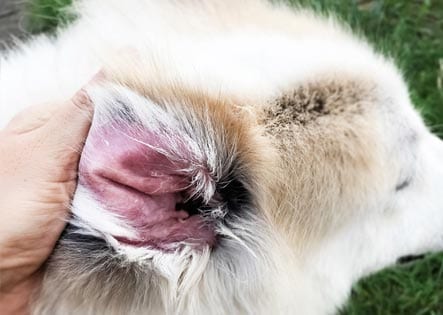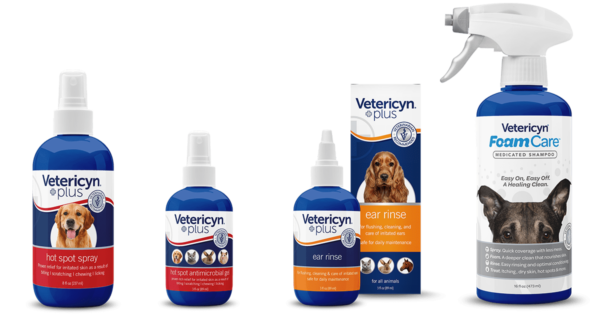
Does your dog seem irritable? Does he or she spend a lot of time scratching and itching? Have you noticed a foul odor coming from his or her skin?
If so, chances are your dog has a yeast infection.
Yeast Infections in Dogs
Yeast dermatitis is an inflammatory skin condition that occurs fairly regularly in dogs, especially in skin folds, ears, between paw pads or in other hot, humid areas of their body. These conditions encourage yeast to reproduce at increased rates until it becomes an overwhelming issue.
 Yeast infections are more likely to occur in dogs whose immune systems have been compromised or suppressed with medications. Often this occurs during allergy season, especially if your dog is taking steroids or antibiotics. Antibiotics don’t cause yeast but being on long-term antibiotics will diminish the normal flora (bacteria) that helps keep yeast under control, which allows the yeast to proliferate and become a problem. In addition, steroids and illness can decrease an animal’s immune system, which will often allow yeast to proliferate.
Yeast infections are more likely to occur in dogs whose immune systems have been compromised or suppressed with medications. Often this occurs during allergy season, especially if your dog is taking steroids or antibiotics. Antibiotics don’t cause yeast but being on long-term antibiotics will diminish the normal flora (bacteria) that helps keep yeast under control, which allows the yeast to proliferate and become a problem. In addition, steroids and illness can decrease an animal’s immune system, which will often allow yeast to proliferate.
Some dogs are more likely to develop yeast infections based on their genetics or body traits like, for example, excessive skin folds. These include, but are not limited to:

Signs Your Dog May Have a Yeast Infection
There are a variety of ways to tell if your dog has a yeast infection. The most common symptoms to keep an eye out for are persistent, intense itchiness and inflammation. Other symptoms can include:

- Skin redness or itching
- Sticky or yellow/green discharge
- Sores
- Greasy coat
- Hair loss
- Smelly skin
- Thickening skin
- Crusty, flaky skin
- Recurring ear infections
How to Treat Yeast Infections in Dogs
If you’re concerned about your dog’s wellbeing, your first step should always be to consult a veterinarian. That being said, a yeast infection in your dog can be easily treated with topical antifungal shampoo simply by applying at the site of infection. Your vet, however, may be able to prescribe a more advanced treatment methods if problems persist or appear to worsen.
The best way to prevent yeast infections is to make sure you dry your dog thoroughly after they get out of the water, along with keeping excess hair trimmed and clean.

Treat Your Dog’s Yeast Infection with Vetericyn Animal Wellness Products
For dogs dealing with yeast infections of the skin, use a medicated shampoo like Vetericyn Medicated FoamCare Shampoo, which is specially formulated to alleviate and manage skin ailments and contains anti-inflammatory and cell-proliferating ingredients to clean, heal, and soothe the skin.
Vetericyn Medicated FoamCare Shampoo is designed to help relieve skin suffering from irritation, itching, and dryness. If you notice redness or skin irritations, use Vetericyn Plus All Animal Hot Spot Spray to soothe and protect the area and prevent it from developing into a more serious irritation.
For pets suffering from yeast issues in the ear canal, use an ear rinse that is formulated to treat yeast infections. To help prevent any recurring ear problems, use Vetericyn Plus All Animal Ear Rinse as part of your regular cleaning or preventative program. This will help remove debris and buildup that could lead to more serious issues like a yeast infection.
Regular cleaning and grooming with Vetericyn products is one of the most effective ways you can help ensure no new skin or ear irritations develop on your pet.
Please consult your veterinarian for more serious issues.


